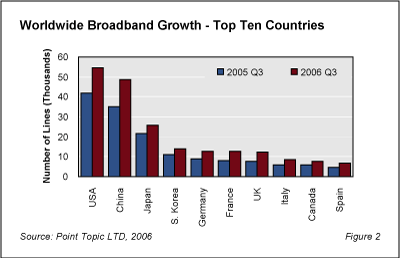The deployment of broadband technologies is driving Internet usage throughout the world–and vice-versa. Compiling statistics from a variety of reliable sources, Computer Economics estimates the total number of Internet users globally to be approximately 1.25 billion. This figure represents a worldwide Internet penetration level of roughly 17% (based on a global population estimate of 6.57 billion according to the U.S. Census Bureau as of February, 2007). The global Internet penetration level continues to grow at a brisk pace, and we project that it will reach 20% of the total world population by 2008. In other words, by sometime next year, one out of every five people in the world will be a user of the Internet.
Much of the new growth is coming from Africa, the Middle East, and Asia. While a few Asian countries (led by Japan, South Korea, and Taiwan) have high Internet penetration levels, it will be some time before the majority of the countries in these regions reach double digit penetration levels. Exceptions to this are Turkey and Vietnam, which currently boast Internet penetration levels of 21% and 17% respectively. Additionally, China currently has an Internet penetration rate of over 9% and Indonesia 8%–both countries are experiencing strong growth and will hit double digit growth figures this year.
As shown Figure 1, the United States still leads all countries in terms of total Internet users, but drops to second place on the list when viewed from the perspective of Internet penetration. Australia now holds a slight lead over the U.S. in terms of penetration, with Canada, Japan, and South Korea rounding out the top five. Filling out the rest of the top ten (in order, from 6th place) are the United Kingdom, Germany, Taiwan, Italy, and France.
With the exception of Italy and France, all of the top ten countries have Internet penetration levels above 60% (Italy currently has a 52% penetration level; France, 50%). After the top ten, Internet penetration levels quickly dip below 20%, clearly indicating that even in countries with large Internet communities there is still plenty of growth to come. The most notable example of this is India which has 40 million Internet users but a penetration rate of only 3.5%.

Broadband Growth Accelerating
As of 3Q06, the total number of broadband lines deployed worldwide exceeded 263 million, according to Point Topic LTD (a U.K.-based research company that focuses on global broadband communications). This represents a 33% increase over the numbers it reported during the same quarter in 2005. While the growth rate is strong, it has actually fallen back somewhat from the 2004/2005 growth rate of 38%. This drop is chiefly due to slower growth in Europe and Southeast Asia. According to Point Topic, the European slowdown occurred because of market saturation, while the Southeast Asian slowdown happened because of slower growth in China and India over the previous year.
The U.S. still leads the world in total number of broadband lines, with 54.5 million as of 3Q06, as shown in Figure 2. The closest rival to the U.S. in sheer number of lines is China with 48.6 million. Both countries are experiencing significant growth, although China is somewhat outpacing the U.S. In 3Q06, China added 3.5 million new broadband lines, while the U.S. added only 2.9 million. Rounding out the top three, Japan added 1.2 million lines during the same quarter. It is estimated that China will surpass the U.S. this year in terms of total broadband lines deployed.
The remainder of the top ten countries falls well below the leaders in terms of total broadband lines deployed, but are nevertheless also experiencing steady growth. Interestingly, none of the top ten are among the current world leaders in annual growth rates as a percentage of their existing broadband subscriber base. The country with the highest annual growth rate is Greece at 243%. In second place is India with an annual growth rate of 185%, followed by Croatia at 150%.

Today, broadband penetration worldwide is only 4.75%, where penetration is defined as the percentage of Internet users whose primary access is via broadband. North America has the highest broadband penetration rate at almost 20%, closely followed by Western Europe at just over 18%. The next highest region is Asia-Pacific coming in at only 8%. This data clearly shows that the market for broadband is still wide open in many regions of the world, led by areas such as Eastern Europe, the Middle East, Africa, and Latin America. It is no coincidence that these regions also have the lowest Internet penetration rates; again supporting the concept that growth in Internet and broadband are now tightly coupled.
DSL Is King–Except in U.S.
Internationally, DSL accounts for the lion’s share of all broadband lines deployed. As of the beginning of 2007, there are an estimated 180 million DSL lines in place worldwide. There are approximately 60 million cable lines deployed globally, while FTTx (fiber technologies) accounts for another 23 million lines worldwide.
The U.S. is the only country with a higher number of cable lines than DSL. Almost 53% of all broadband connections in the U.S. are deployed via cable–a testimony to the strength of the cable industry in the States. DSL is growing in the U.S. and may eventually surpass cable, but both technologies will likely maintain a near 50/50 share for quite some time to come.
Computer Economics projects that the number of worldwide broadband lines will exceed 500 million by the end of 2010. As broadband growth continues to accelerate, this will also fuel growth in Internet connectivity on a global basis. We expect that by year-end 2010 approximately one-third of the world population will be active members of the global Internet community.
February 2007

